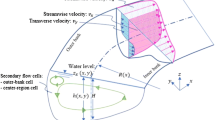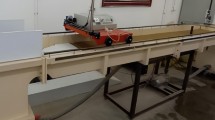Abstract
The hydrodynamic modeling of debris flows is challenged by the complicated mechanism of debris flow and the large variability of material composition. Therefore, in the dynamic continuum modeling of debris flows it is essential to select suitable rheological and associated friction parameters. The quadratic rheological model is the most comprehensive approach because it considers the effects of viscous behavior, solid-particle resistance, turbulent properties, and friction characteristics of debris flow. Therefore, this study adopted the quadratic model as the governing flow resistance stress and analyzed the influence of various flow resistance stresses to evaluate the runout performance. The shallow-water equations with modified bottom friction were discretized and the developed model was validated against a dam break flow and a ‘spreading of circular cone’ problem. Then, to investigate the relationship between the flow resistance relations and the bottom shear stresses exerted by the cones and dry bed, the model was applied to runout in a rectangular domain with three cone-shaped obstacles. An actual field runout event that occurred in Korea in 2011 was replicated and the runout paths and flow patterns were analyzed according to the various resistance stresses. By considering both the extremely rapid runout velocity and the striking run-up height, the results obtained by the quadratic stress relation achieved the best performance. However, for the successful application of the quadratic approach, three parameters had to be adjusted with consideration to locality.












Similar content being viewed by others
References
Akbar M, Aliabadi S (2013) Hybrid numerical methods to solve shallow water equations for hurricane induced storm surge modeling. Environ Model Softw 46:118–128
Agoshkov VI, Marchuk GI (1993) On the solvability and numerical solution of data assimilation problems. Russ J Numer Anal Math Model 8(1):1–16
Ayotte D, Hungr O (2000) Calibration of a runout prediction model for debris-flows and avalanches. In: Wieczorek GF, Naeser ND Proceedings of the second international conference on debris-flow hazards mitigation. AA Balkema, Rotterdam (pp. 505–514)
Brufau P, Vázquez-Cendón ME, García-Navarro P (2002) A numerical model for the flooding and drying of irregular domains. Int J Numer Meth Fluids 39(3):247–275
Brunsden D (1999) Some geomorphological considerations for the future development of landslide models. Geomorphology 30(1–2):13–24
Bryant S, Duncan JM, Seed HB (1983). Application of tailings flow analyses to field conditions. US Department of Interior, Bureau of Mines, Open-File Report, pp 53–84
Chen H, Lee CF (2004) Geohazards of slope mass movement and its prevention in Hong Kong. Eng Geol 76(1–2):3–25
Dai FC, Lee CF, Ngai YY (2002) Landslide risk assessment and management: an overview. Eng Geol 64(1):65–87
Denlinger RP, Iverson RM (2001) Flow of variably fluidized granular masses across three-dimensional terrain: 2. Numerical predictions and experimental tests. J Geophys Res Solid Earth 106(B1):553–566
Dresback KM, Kolar RL, Dietrich JC (2002) Impact of the form of the momentum equation on shallow water models based on the generalized wave continuity equation. Dev Water Sci 47:1573–1580
George DL, Iverson RM (2014) A depth-averaged debris-flow model that includes the effects of evolving dilatancy. II. Numerical predictions and experimental tests. Proc R Soc A 470(2170):20130820
Gray WG, Lynch DR (1979) On the control of noise in finite element tidal computations: a semi-implicit approach. Comput Fluids 7(1):47–67
Gresho PM, Sani RL (1998) Incompressible flow and the finite element method. Wiley, Hoboken
Heinrich JC, Pepper DW (1999) Intermediate finite element method: fluid flow and heat transfer applications. Taylor & Francis, Milton Park
Hungr O (1995) A model for the runout analysis of rapid flow slides, debris flows, and avalanches. Can Geotech J 32(4):610–623
Hungr O, Evans SG (1997) A dynamic model for landslides with changing mass. Eng Geol Environ 41:719–722
Hungr O, McDougall S, Bovis M (2005) Entrainment of material by debris flows. In: Debris-flow hazards and related phenomena. Springer, Berlin, pp 135–158
Iverson RM (1997) The physics of debris flows. Rev Geophys 35(3):245–296
Iverson RM, Denlinger RP (2001) Flow of variably fluidized granular masses across three-dimensional terrain: 1. Coulomb mixture theory. J Geophys Res Solid Earth 106(B1):537–552
Iverson RM, George DL (2014). A depth-averaged debris-flow model that includes the effects of evolving dilatancy. I. Physical basis. Proc R Soc A 470(2170), 20130819
Jakob M, Hungr O, Jakob DM (2005) Debris-flow hazards and related phenomena, vol 739. Springer, Berlin
Jin M, Fread DD (1999) 1D modeling of mud/debris unsteady flows. J Hydraul Eng 125(8):827–834
Julien PY, Lan Y (1991) Rheology of hyperconcentrations. J Hydraul Eng 117(3):346–353
Julien PY, O’Brien JS (1997) Selected notes on debris flow dynamics. In: Recent developments on debris flows. Springer, Berlin, pp 144–162
Kawahara M, Umetsu T (1986) Finite element method for moving boundary problems in river flow. Int J Numer Meth Fluids 6(6):365–386
Korean Geotechnical Society (2011) Final report of the cause investigation and recovery measures at Mt. Umyeon landslide. Seoul Metropolitan Government
Liang Q, Borthwick AG (2009) Adaptive quadtree simulation of shallow flows with wet–dry fronts over complex topography. Comput Fluids 38(2):221–234
Liu KF, Huang MC (2006) Numerical simulation of debris flow with application on hazard area mapping. Comput Geosci 10(2):221–240
Liu KF, Mei CC (1989) Slow spreading of a sheet of Bingham fluid on an inclined plane. J Fluid Mech 207:505–529
Murillo J, García-Navarro P (2012) Wave Riemann description of friction terms in unsteady shallow flows: application to water and mud/debris floods. J Comput Phys 231(4):1963–2001
Naef D, Rickenmann D, Rutschmann P, McArdell BW (2006) Comparison of flow resistance relations for debris flows using a one-dimensional finite element simulation model. Nat Hazards Earth Syst Sci 6(1):155–165
Quecedo M, Pastor M (2003) Finite element modelling of free surface flows on inclined and curved beds. J Comput Phys 189(1):45–62
Rickenmann D (2005) Runout prediction methods. In: Debris-flow hazards and related phenomena. Springer, Berlin, pp 305–324
Schraml K, Thomschitz B, McArdell BW, Graf C, Kaitna R (2015) Modeling debris-flow runout patterns on two alpine fans with different dynamic simulation models. Nat Hazards Earth Syst Sci 15(7):1483
Seo IW, Kim YD, Song CG (2014). Validation of depth-averaged flow model using flat-bottomed benchmark problems. Sci World J, 2014
Song CG, Oh T (2016) Transient SU/PG modelling of discontinuous wave propagation. Progress Comput Fluid Dyn An Int J 16(3):146–162
Takahashi T (2001). Mechanics and simulation of snow avalanches, pyroclastic flows and debris flows. Particulate gravity currents, IAS Special Publication, (31), 11–43
Te Chow V (1959) Open-channel hydraulics, vol 1. McGraw-Hill, New York
Yoo KY, Won JS, Yoo YM (2014) Additional and complementary research on landslide causes in Mt. Umyeon–final report. Seoul Metropolitan Government, Seoul, p 452
Yu CC, Heinrich JC (1987) Petrov—Galerkin method for multidimensional, time dependent, convective diffusion equations. Int J Numer Methods Eng 24(11):2201–2215
Acknowledgements
This research was supported by a Grant (18CTAP-C133019-02) from the Technology Advancement research Program funded by the Ministry of Land, Infrastructure and Transport of Korean government.
Author information
Authors and Affiliations
Corresponding author
Rights and permissions
About this article
Cite this article
Lee, S.O., Song, C.G. Influence of flow resistance stresses on debris flow runout. Environ Earth Sci 77, 426 (2018). https://doi.org/10.1007/s12665-018-7604-2
Received:
Accepted:
Published:
DOI: https://doi.org/10.1007/s12665-018-7604-2




